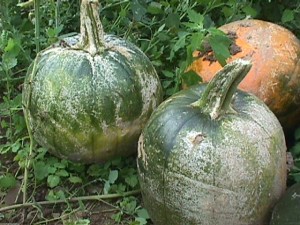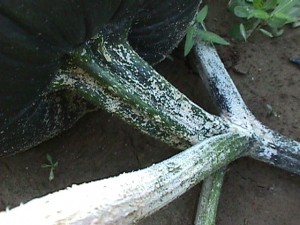For over a decade, basil downy mildew (BDM) has caused significant losses in basil grown in organic and conventional field and greenhouse production across the United States. At the time of its introduction, there were very few fungicides labeled for its control making it nearly impossible to grow a successful crop in many areas of the country. The pathogen, Peronospora belbahrii, is an obligate parasite, meaning it needs a living host in order to survive. Thus, in more northern regions of the country that experience a freeze (i.e., winter), the pathogen will die when the host freezes during the fall. Because of this, the pathogen must be re-introduced the following spring or summer from southern regions of the country. This is similar to cucurbit downy mildew, where the pathogen can survive on the host that is growing in the field during the winter months (e.g., southern Florida or Mexico). The exact timing of when basil downy mildew may show up in your geographic region depends on a number of factors. The more southern you are located in the continental US, the more likely the pathogen will show up earlier in the spring or summer. In New Jersey the pathogen has been reported as early as 12 June and as late as 2 August. The first step in mitigating losses to basil downy mildew is in your selection of the best varieties. In recent years, there have been a number of new commercial sweet basil varieties released with a high level of resistance to basil downy mildew. Sweet basil varieties without BDM resistance should always be grown prior to the expected arrival of the pathogen in your region. There is a BDM monitoring website, led by Cornell University, which tracks the movement of the pathogen across the country each year. Growers can use the website to see where BDM has been reported across the country. Once BDM has been detected in your area you can expect it to remain active until the end of the production season. BDM resistant sweet basil varieties should always be grown after BDM has been detected in your region to help mitigate losses due to the disease. If you are located in the southern US, the easiest approach would be to use BDM resistant sweet basils the entire production season. All basil growers must remember that any of the new BDM resistant sweet basils are not “immune” to the disease. If disease pressure becomes extremely high or environmental conditions become highly conducive for disease development over a long period of time BDM resistance will break down for that season. Thus, it is extremely important to still initiate a fungicide program when using any DMR resistant sweet basil, especially if disease pressure is expected to be high.
For several years, the IR-4 Project has been working diligently with stakeholders and registrants to facilitate the registrations for a number of fungicide products (conventional, biopesticide, and organic) to control basil downy mildew. These efficacy studies have been done by Extension personnel at many Universities across the country. The following is a comprehensive list of conventional, organic, and biopesticides currently labeled for the control of BDM in the US.
Conventional fungicides currently labeled for basil downy mildew control:
- Ranman 400 SC, FMC Agricultural Products
- cyazofamid, FRAC Group 21
- Can be used in a greenhouse, 0-day PHI
- Revus, Syngenta Crop Protection,
- mandipropamid, FRAC Group 40
- Micora labeled for use in the greenhouse; 1-day PHI
- Ridomil Gold, Syngenta Crop Protection
- mefenoxam, FRAC Group 4
- Field use only; 21-day PHI
- Orondis Ultra, Syngenta Crop Protection (not yet approved by EPA)
- oxathiapiprolin (FRAC Group 49) + mandipropamid (FRAC Group 40)
- Field use only (foliar); 0-day PHI
- Segovis, Syngenta Crop Protection
- oxathiapiprolin, FRAC Group 49
- Greenhouse use only; transplants for retail sale
- Presidio, Valent USA
- fluopicolide, FRAC Group 43
- Field use only; 1-day PHI;
- Adorn labeled for use in the greenhouse
- Reason 500SC, Gowan Company and Bayer CropScience LP
- fenamidone, FRAC Group 11
- Field and greenhouse use; 2-day PHI
Organic Materials Review Institute (OMRI Listed) federally registered fungicide products for basil downy mildew control include:
- Actinovate AG (Streptomyces lydicus, Novozymes BioAg Inc.)
- Double Nickel 55 and LC (Bacillus amyloliquefaciens strain D747 Certis U.S.A.)
- Aviv (Bacillus subtilis strain IAB/BS03, STK Bio-Ag Technologies)
- Regalia (extract of Reynoutria sachalinensis, Marrone Bio Innovations)
- Trilogy (neem oil, Certis U.S.A.)
- Milstop, Carb-O-Nator (potassium bicarbonate, BioWorks Inc., Certis USA LLC)
- Oxidate (hydrogen dioxide, BioSafe Systems LLC)
- Oxidate 2.0 (hydrogen dioxide; peroxyacetic acid, BioSafe Systems LLC).
- Cueva Fungicide Concentrate (copper octanoate, Certis USA, LLC)
- Romeo (cell walls of Saccharomyces cerevisiae strain LAS117, Lesaffre Yeast Corporation)
Biopesticide products federally registered for basil downy mildew control that are not OMRI listed include:
- mono- and di-potassium salts of phosphorous acid (K-Phite, Plant Food Systems)
- phosphorous acid, mono- and dipotassium salts (Confine Extra, Winfield Solutions LLC)
- phosphorous acid, mono- and dibasic sodium, potassium, and ammonium salts (Alude and Phostrol, Nufarm Agricultural Products)
- potassium phosphite (Fosphite, JH Biotech, Inc.; Fungi-Phite, Plant Protectants, LLC; Prophyt, Helena Chemical Company; Rampart, Loveland Products, Inc.)
- potassium bicarbonate (Armicarb 100, Helena Chemical Company)
- a combination of potassium phosphate and potassium phosphite (Phorcephite, Loveland Products, Inc.)
- sodium tetraborohydrate decahydrate (Prev-Am Ultra ORO Agri, Inc.)
- hydrogen peroxide, peroxyacetic acid (Rendition, Certis USA LLC)
- hydrogen peroxide; phosphorous acid; mono- and dipotassium salts (Oxiphos, BioSafe Systems LLC)
- citric acid (Procidic, Greenspire Global Inc.)
- hydrogen peroxide; peroxyacetic acid (Sanidate 12.0, BioSafe Systems, LLC)
- Sodium tetraborohydrate decahydrate (Prev-Am Ultra, ORO Agri, Inc.)
- Laminarin (Vacciplant, UPL NA Inc.)
Some important points to consider:
- Some of the conventional fungicides listed above are sold under different product names, depending on whether the product can be used in the field or greenhouse or for greenhouse transplant use. Other products have both a field and greenhouse use on the same product label.
- Although a product is listed as a biopesticide, it does not mean it has an OMRI-approved label. All growers should follow labels accordingly. Remember, the label is the law.
Proper control of BDM depends on a number of factors including the environment, disease pressure, and the timing of fungicide applications. Prolonged periods of wet weather and high relative humidity during the production season will make BDM control more difficult regardless of the products used to control it. The amount of disease pressure present in your field will also have an impact on your ability to control BDM. This is especially important in organic production systems where organic products often have better chance of working if disease pressure remains low. This is why growing a basil downy mildew resistant sweet basil is so important; as many organic products as reported by growers have not shown to be as effective as needed.
Research has shown that fungicide applications (e.g., conventional, bio-, or organic) initiated after the start of disease development most often leads to poor control and crop loss. Therefore, it is important to anticipate the arrival of BDM and initiate a fungicide program prior to the onset of disease development. This is also why monitoring the progress of the pathogen in the US is so important. In some areas, the disease might arrive on infected basil transplants from southern states. If this happens, the basil downy mildew will be in present long before the anticipated arrival of the pathogen due to weather patterns.
How products work against basil downy mildew
Conventional fungicides often work by inhibiting spore germination or spore production. Thus, the importance of having them applied prior to the arrival of the pathogen. Some of these products, such as mefenoxam or oxathiapiprolin, move within the plant, giving them an advantage when applied as drip applications. Biopesticides, such as the phosphites, are truly systemic and move up and down within the plants vascular system; however, research has shown that phosphites are more effective as foliar applications than when applied as drip applications. Some biopesticides, such as Oxidate and hydrogen peroxide, act as disinfestants killing spores they come into direct contact with. Because BDM sporulates on the underside of the leaf, these products (and most other fungicides) must reach the undersides of leaves during application in order to be effective. The same holds true for copper products. Copper is a protectant fungicide inhibiting spore germination. Therefore, it must reach the undersides of leaves. Organic products, such as those containing Bacillus and Streptomyces, act as an antigonist against BDM on the leaf surface and must be remain present in high enough populations on the leaf surface to provide control. This is often difficult to do because it requires multiple applications per week with short retreatment intervals. Often, these products are ineffective due to unfavorable environmental conditions. For growers trying to reduce conventional fungicide use, these products as well as disinfectant products will also kill off any biological control agents, so beware.
For information on Rutgers DMR sweet basils, where to purchase seed, as well as control strategies, and ongoing research efforts please follow the Rutgers basil downy mildew breeding program on Instagram at #Rutgersbasil.
Additional Resources:
Tracking basil downy mildew in the US
Fungicides for the control of BDM
Controlling basil downy mildew in the greenhouse
By: Andy Wyenandt, Kathryn Homa (IR-4 Project), and Jim Simon, Department of Plant Biology, NJAES, Rutgers University



